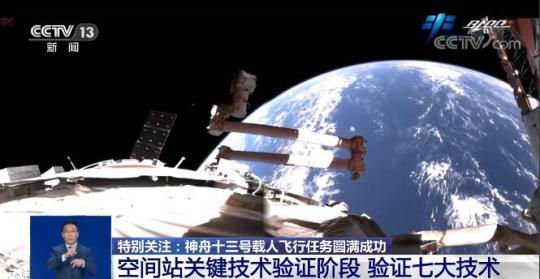The triumph of Shenzhou 13, the key technology verification stage of China's space station has come to a successful end
CCTV News: The Shenzhou 13 mission is the decisive battle and the final battle in the verification stage of the key technology of the space station, and it is also a key battle to link the past and the future in the orbital construction of the space station.
The return of Shenzhou 13 also marks the successful conclusion of the key technology verification stage of the space station.
So, what key technologies have been verified at this stage, and what role do these technologies play in the future construction of space stations?
On April 29, 2021, the first vehicle for the China Space Station mission, the Tianhe core module, was successfully launched, embarking on a journey to explore the universe.
During the one year in orbit, the manned space project has completed a total of 5 launch missions, sending the Tianhe core module, 2 manned spacecraft and 2 cargo spacecraft into space.
Seven key technologies were verified on-orbit, including: space station propellant replenishment, regenerative life insurance, flexible solar cell wings and drive mechanisms, large-scale flexible assembly control, assembly and construction, extravehicular operations, and on-orbit maintenance.
The Tianhe core module is the largest and most complex spacecraft developed by my country so far. It not only needs to carry astronauts for long-term residence, but also conducts a large number of scientific experiments and technical verifications in orbit, all of which require sufficient power as support.
To this end, scientists have customized a new space "wing" for it - a flexible solar cell array.
Compared with the traditional solar cell array, the thickness of the flexible solar wing veneer is less than 1mm, and the weight per unit area is only half of the traditional solar cell array. life.
In addition to sufficient energy supply, in terms of manned environment control, the core cabin is equipped with a regenerative life support system, which realizes the regeneration of oxygen in the cabin, the treatment of human metabolites such as carbon dioxide, the removal of harmful gases, and the recycling of water resources. , to ensure the long-term stay of astronauts in orbit, and greatly reduce the upward carrying capacity of consumables such as oxygen and water.
It is equipped with an active temperature control fluid circuit, that is, an air conditioning system, to ensure that the air temperature, humidity and the working temperature of the instruments and equipment are within the appropriate range to ensure the safety and comfort of the residence.
Berlin Hou, deputy chief designer of the space station system of the Fifth Academy of Aerospace Science and Technology Group: We use regenerative life protection technology, we can recycle the condensed water collected in the cabin or the urine of astronauts, and then reprocess it later , process it into drinking water.
At the same time we will electrolyze it into oxygen that the astronauts can use.
This is also our first use.
We actually have this whole system working very well so far.
Including the 3-month stay period of the Shenzhou 12 crew and the 6-month stay of the Shenzhou 13 crew, the entire system has been used very well.
That is to say, in fact, a total of these two astronaut crews, and then a total of 9 months in orbit, all of us are using renewable resources.

